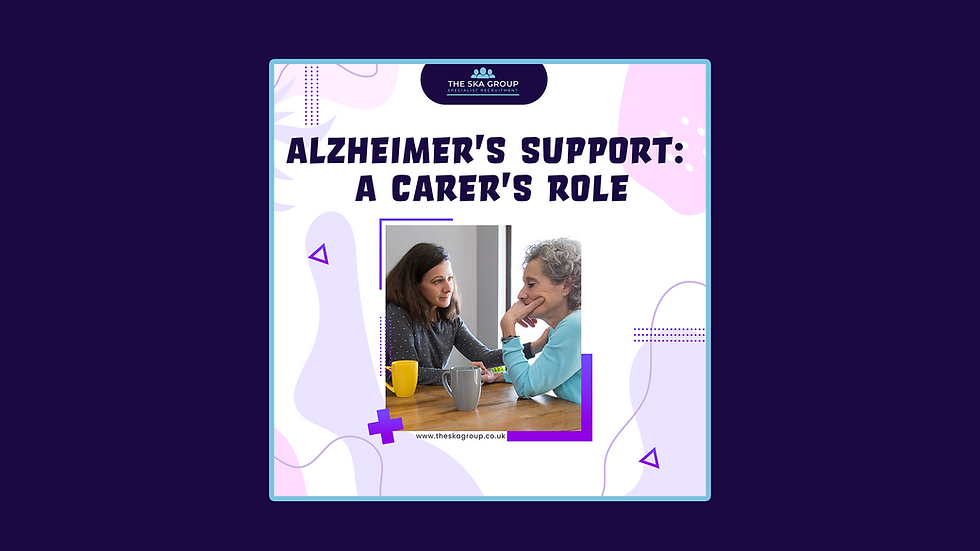Learning Disability Awareness Week: Building Inclusive Spaces for All
- Emily

- Jun 18
- 4 min read
Updated: Jun 26
Learning Disability Awareness Week is a time to reflect on inclusion and action. While awareness is critical, real change comes when we actively design our environments—physical, digital, and social—with everyone in mind.
For individuals with learning disabilities, accessibility is more than just wheelchair ramps and elevators. It encompasses communication, understanding, and respect for diverse ways of thinking and processing the world. This article explores practical steps that individuals, businesses, schools, and organizations can take to create inclusive spaces for people with learning disabilities.
Why Accessibility for Learning Disabilities Matters
A learning disability is a neurological condition affecting how a person understands, remembers, and processes information. Common examples include dyslexia (difficulty with reading), dyscalculia (challenges with numbers), and dyspraxia (affecting coordination and planning). These conditions are not linked to intelligence but impact daily life in school, work, and public spaces.
People with learning disabilities often face barriers that others overlook. From overly complex signage to rushed customer service interactions, these everyday challenges add up. True accessibility means these barriers are identified and removed. They should be replaced with supportive measures that foster independence and confidence.
1. Use Clear and Simple Communication
Many individuals with learning disabilities benefit from straightforward language and clear instructions.
Tips:
Use plain English—avoid jargon, acronyms, and overly complex sentences.
Break information into small, digestible chunks.
Implement bullet points or numbered steps for tasks or instructions.
Provide both verbal and written versions of information when possible.
Example:
In a healthcare setting, instead of saying, “Your next appointment is contingent on the previous diagnostic results,” say, “We’ll book your next appointment after we get your test results.”
2. Incorporate Visual Supports
Visual cues can enhance understanding and retention of information for individuals with learning disabilities.
Tips:
Use clear symbols or images alongside written text (e.g., toilet signs, exits, food menus).
Offer visual schedules or step-by-step guides with pictures.
Utilize color coding to highlight categories or important steps.
Example:
In a classroom, a visual daily timetable helps students anticipate what's next and reduces anxiety.
3. Provide Time and Patience
Processing information may take longer for some individuals with learning disabilities. Rushing or interrupting can lead to confusion and distress.
Tips:
Allow extra time for responses and decision-making.
Ask, “Would you like me to repeat that?” instead of assuming someone isn’t paying attention.
Avoid finishing sentences for someone who may be struggling—give them the space to express themselves.
Example:
In a customer service setting, train staff to wait patiently and listen actively. This approach can create a more inclusive experience.
4. Design Inclusive Physical Spaces
The layout and signage of a space can greatly affect how easy it is to navigate for someone with a learning disability.
Tips:
Use consistent, clearly labeled signs with symbols and large fonts.
Avoid visual clutter—too many signs or bright colors can be overwhelming.
Provide quiet zones or low-stimulation areas where individuals can take a break.
Example:
A community center might feature a sensory-friendly room with soft lighting and minimal noise.
5. Offer Choices and Support Decision-Making
While independence is important, so is support. Individuals with learning disabilities may need help understanding their options without feeling pressured.
Tips:
Present options one at a time if multiple choices are overwhelming.
Use real-life examples to clarify abstract concepts.
Provide written or visual supports when asking for decisions.
Example:
When offering meal choices, showing pictures or samples can simplify the selection process compared to a text-only menu.
6. Ensure Digital Accessibility
Online spaces must also be accessible, especially as many services have shifted to digital platforms.
Tips:
Implement accessible website design with clear navigation and readable fonts.
Include alt-text for images and avoid flashing graphics.
Provide audio versions of written content whenever possible.
Ensure forms are straightforward and do not request unnecessary information.
Example:
An employment site could include "easy-read" job descriptions and video explainers about the application process.
7. Train Staff and Volunteers
Inclusion starts with people. Training staff to understand learning disabilities fosters empathy and helps avoid unintentional exclusion.
Tips:
Provide training on learning disabilities, communication styles, and inclusive practices.
Use role-play scenarios to help staff learn how to support individuals respectfully.
Encourage a culture of curiosity—ask “How can we make this easier for you?” when in doubt.
Example:
Libraries that train staff to assist people with reading or form-filling needs often see increased community engagement.
8. Involve People with Learning Disabilities in Design
Perhaps the most vital action: Nothing about us without us. When designing inclusive spaces, involve those who will use them.
Tips:
Invite individuals with learning disabilities to provide feedback on your service or environment.
Co-design projects with people who have lived experience.
Conduct user testing before launching new programs or websites.
Example:
A local authority that collaborates with people with learning disabilities to design public signage is likely to produce more effective and inclusive results.
Creating a Culture of Belonging
Accessibility is not merely a checklist—it’s a mindset. It’s about choosing empathy over convenience and inclusion over assumption. By fostering environments where people with learning disabilities feel safe, respected, and understood, we build stronger and more compassionate communities for all.
This Learning Disability Awareness Week, let’s commit to making *inclusion the default*—not the exception.




Comments